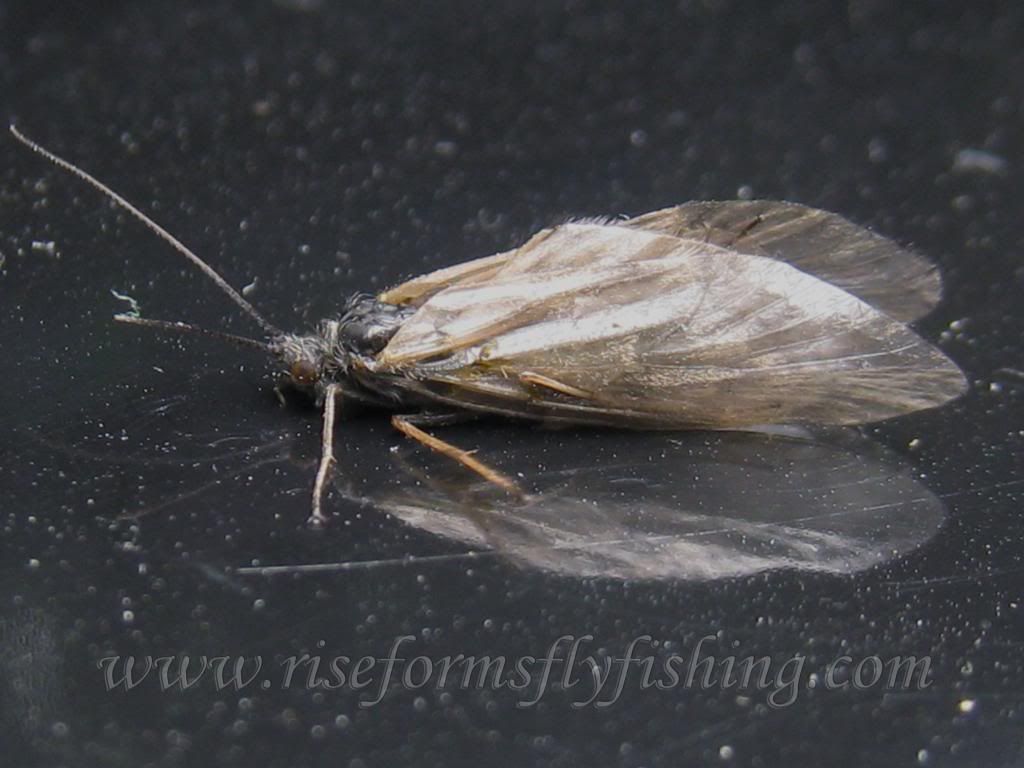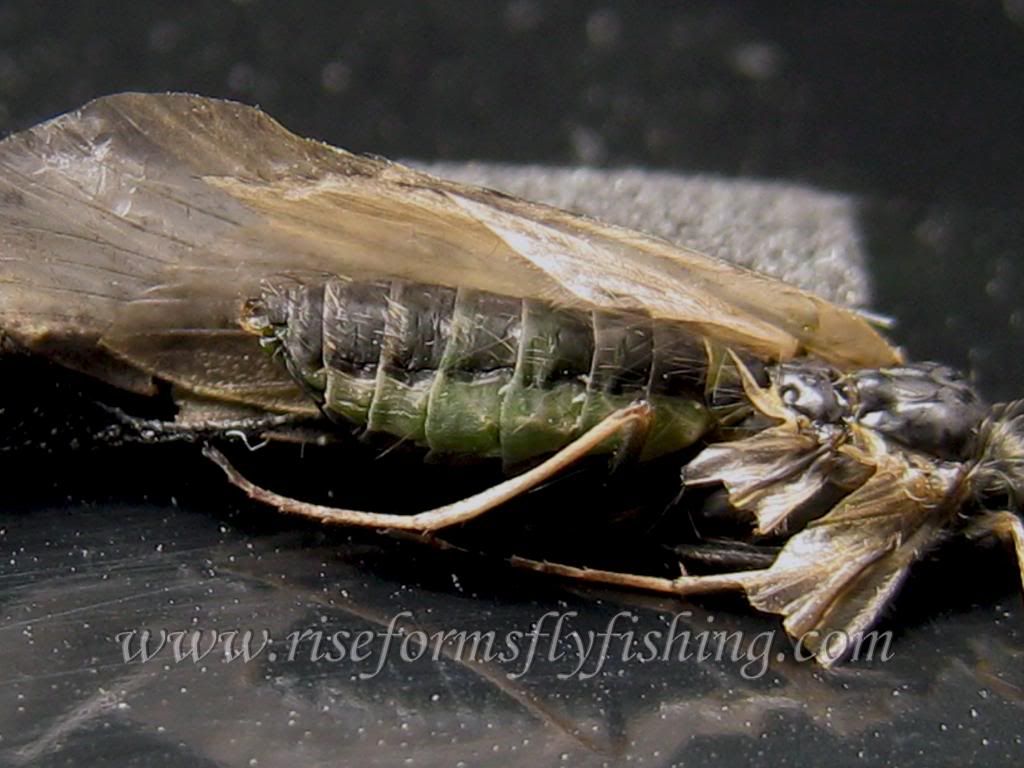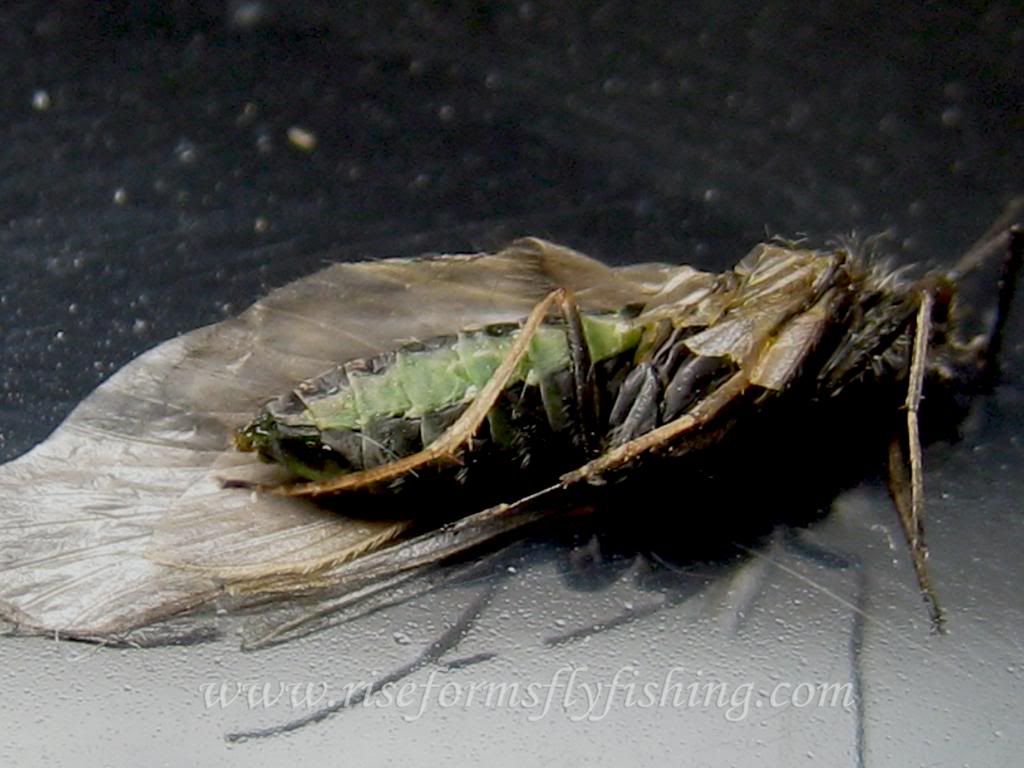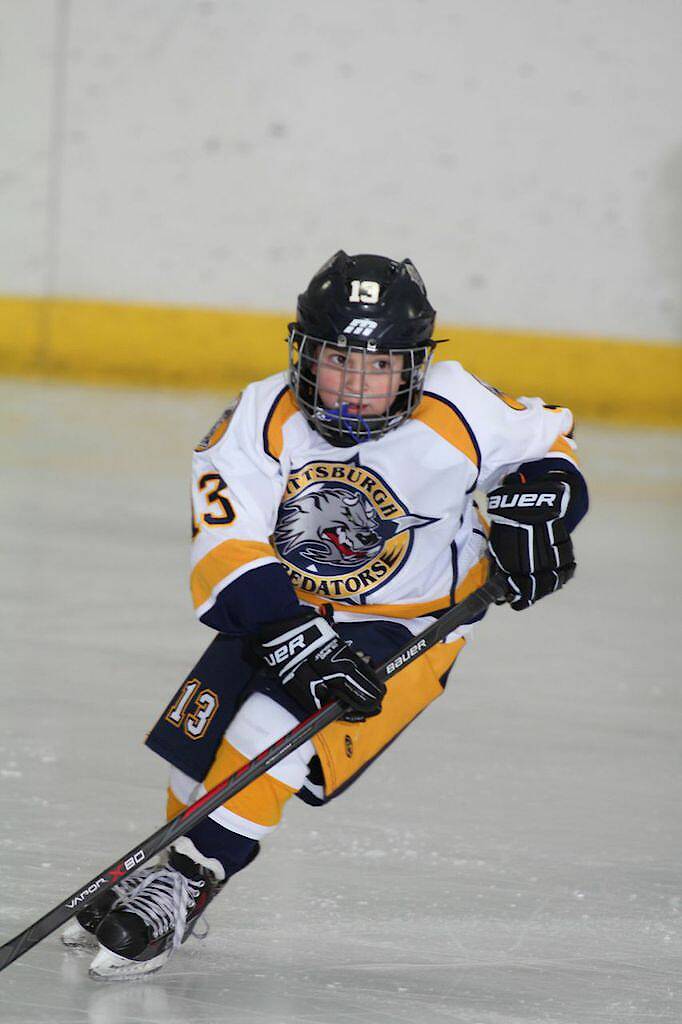
Blue-winged Olives
Baetis
Tiny Baetis mayflies are perhaps the most commonly encountered and imitated by anglers on all American trout streams due to their great abundance, widespread distribution, and trout-friendly emergence habits.
Featured on the forum

This is an interesting one. Following the keys in Merritt R.W., Cummins, K.W., and Berg, M.B. (2019) and Jacobus et al. (2014), it keys clearly to Ephemerella. Jacobus et al provide a key to species, but some of the characteristics are tricky to interpret without illustrations. If I didn't make any mistakes, this one keys to Ephemerella mucronata, which has not previously been reported any closer to here than Montana and Alberta. The main character seems to fit well: "Abdominal terga with prominent, paired, subparallel, spiculate ridges." Several illustrations or descriptions of this holarctic species from the US and Europe seem to match, including the body length, tarsal claws and denticles, labial palp, and gill shapes. These sources include including Richard Allen's original description of this species in North America under the now-defunct name E. moffatae in Allen RK (1977) and the figures in this description of the species in Italy.

Troutnut is a project started in 2003 by salmonid ecologist Jason "Troutnut" Neuswanger to help anglers and
fly tyers unabashedly embrace the entomological side of the sport. Learn more about Troutnut or
support the project for an enhanced experience here.
Sayfu
Posts: 560
Posts: 560
Sayfu on Mar 26, 2013March 26th, 2013, 4:24 pm EDT
That looks good, and I can see where it could be a trigger. I purchased some gray "EP fibers" several years ago in the fly shop, and have had great success using them as the subsurface wing for my Albertae emergers to winging for my small BWO's that makes it simple to weave through the middle of them, and pull them up as wings. I include them in my Comparadun wing to provide the gray color, the wet look sparkle effect. And they would work well as the wings and veil effect for caddis pupa. Think I will go tie one.
Creno on Mar 26, 2013March 26th, 2013, 8:20 pm EDT
Eric - degree of color, particularly of the abdomen, and the width of the plural area are going to be individual characters, not species specific. The plural area is highly membranous. It is designed to expand and contract to fit the critters needs - expanded with eggs, contracted without - expanded with a breath contracted without? I doubt expansion from breathing is obvious to us but who knows. Expansion with eggs is very obvious.
The subapical lobe size is one of those relative things in keys. Not all that useful for folks who don't have experience with the range of variability within the genus and a species. One should try hard not to use characters based on relative differences but sometimes it cannot be avoided. Brachycentrus males are difficult and I find the females pretty much indistinguishable. I can readily separate the western species but don't have enough experience with the eastern females to feel confident. In general the females of North American caddis are poorly known. It is a shame that more folks don't collect males and females so that better associations could be worked out for the future.
The subapical lobe size is one of those relative things in keys. Not all that useful for folks who don't have experience with the range of variability within the genus and a species. One should try hard not to use characters based on relative differences but sometimes it cannot be avoided. Brachycentrus males are difficult and I find the females pretty much indistinguishable. I can readily separate the western species but don't have enough experience with the eastern females to feel confident. In general the females of North American caddis are poorly known. It is a shame that more folks don't collect males and females so that better associations could be worked out for the future.
Crepuscular on Mar 27, 2013March 27th, 2013, 5:21 am EDT
The subapical lobe size is one of those relative things in keys. Not all that useful for folks who don't have experience with the range of variability within the genus and a species.
That is exactly why I was not comfortable saying that what I have is B. solomoni. Here is another adult that had been out for a while (not sure how long). I cut the starboard side wings so the abdomen is visible. I guess I should have said that I collected these from the Yellow Breeches.




Creno on Mar 27, 2013March 27th, 2013, 7:33 am EDT
This specimen is a female with eggs still present
Martinlf on Mar 27, 2013March 27th, 2013, 9:38 am EDT
I've seen patterns with a green ball at the end of the abdomen. I'm assuming this is to mimic the extruded eggs, ready to be dropped. Any comments on these patterns? Some use them as a "secret weapon" for picky fish, or for the egg laying periods.
"He spread them a yard and a half. 'And every one that got away is this big.'"
--Fred Chappell
--Fred Chappell
Entoman on Mar 27, 2013March 27th, 2013, 10:47 am EDT
Most commercial patterns use shades of green that make them more attractor patterns than imitative. The eggs I see hanging from Grannoms out West range from forest green to almost black. What are the colors of your eastern varieties?
"It's not that I find fishing so important, it's just that I find all other endeavors of Man equally unimportant... And not nearly as much fun!" Robert Traver, Anatomy of a Fisherman
Martinlf on Mar 27, 2013March 27th, 2013, 11:17 am EDT
For the Grannom, green.
"He spread them a yard and a half. 'And every one that got away is this big.'"
--Fred Chappell
--Fred Chappell
Entoman on Mar 27, 2013March 27th, 2013, 12:01 pm EDT
Ah! the Bruce & Tony treatment...:)LOL
What shade? Do they match the flies you mentioned? As for use, I don't mess with them on dry flies but do throw a ball of matching dubbing on some of the divers I use. Whether they work better for me than those without is still before the jury (and it's been out quite awhile):).
What shade? Do they match the flies you mentioned? As for use, I don't mess with them on dry flies but do throw a ball of matching dubbing on some of the divers I use. Whether they work better for me than those without is still before the jury (and it's been out quite awhile):).
"It's not that I find fishing so important, it's just that I find all other endeavors of Man equally unimportant... And not nearly as much fun!" Robert Traver, Anatomy of a Fisherman
Entoman on Mar 27, 2013March 27th, 2013, 1:08 pm EDT
BTW Eric, do you remember the color of the pharate's wing pads? Were they the color of the wings we are seeing or did they appear much darker under compression?
"It's not that I find fishing so important, it's just that I find all other endeavors of Man equally unimportant... And not nearly as much fun!" Robert Traver, Anatomy of a Fisherman
Martinlf on Mar 27, 2013March 27th, 2013, 3:48 pm EDT
Kurt, I actually don't know. I've observed various egg masses, and they have varied in color, but some were for caddis I could not identify. I actually wasn't being facetious, just as accurate as I could be, given my limited knowledge.
For example, here's a bit from one journal entry for late May on the Letort: "Noticed some larger 14?? tan caddis with green body. Pretty patterned wing. Long antenna. Green egg mass." Perhaps Eric will have some idea, but I was clueless as to what this might be.
For example, here's a bit from one journal entry for late May on the Letort: "Noticed some larger 14?? tan caddis with green body. Pretty patterned wing. Long antenna. Green egg mass." Perhaps Eric will have some idea, but I was clueless as to what this might be.
"He spread them a yard and a half. 'And every one that got away is this big.'"
--Fred Chappell
--Fred Chappell
Entoman on Mar 27, 2013March 27th, 2013, 4:49 pm EDT
No problem, Louis. Sorry for the misinterpretation. I thought some of our poking had moved over from the other thread.:)
Your mention of the stream log (and their limitations) illustrates the value of what we're doing here. Many times over the years I've gone back to fish a stream I haven't fished in awhile with flies tied from memory refreshed by stream log. Often, they weren't even close...:)LOL Now when you guys find interesting critters you can take them to Eric for photos we can muse over all Winter.;) Even if we can't decide what they are we'll sure have better models to fashion flies from than the typical terse log entry & fickle memory.
Your mention of the stream log (and their limitations) illustrates the value of what we're doing here. Many times over the years I've gone back to fish a stream I haven't fished in awhile with flies tied from memory refreshed by stream log. Often, they weren't even close...:)LOL Now when you guys find interesting critters you can take them to Eric for photos we can muse over all Winter.;) Even if we can't decide what they are we'll sure have better models to fashion flies from than the typical terse log entry & fickle memory.
"It's not that I find fishing so important, it's just that I find all other endeavors of Man equally unimportant... And not nearly as much fun!" Robert Traver, Anatomy of a Fisherman
Crepuscular on Mar 27, 2013March 27th, 2013, 5:37 pm EDT
BTW Eric, do you remember the color of the pharate's wing pads? Were they the color of the wings we are seeing or did they appear much darker under compression?
They were only slightly darker.
Crepuscular on Mar 27, 2013March 27th, 2013, 5:42 pm EDT
For example, here's a bit from one journal entry for late May on the Letort: "Noticed some larger 14?? tan caddis with green body. Pretty patterned wing. Long antenna. Green egg mass." Perhaps Eric will have some idea, but I was clueless as to what this might be.
Eric is mostly clueless but maybe a Limnephillid? Possibly Limnephilus rhombicus sorry I don't have a photo for the adult but here is one http://bugguide.net/node/view/190882/bgimage
Edit- I re-read your post Louis, and those Limnephilids are probably a little bigger than a #14. so it could possibly be Neophylax, but they may be a little smaller than #14. So like I stated before Eric is pretty much clueless...
Gutcutter on Mar 28, 2013March 28th, 2013, 4:26 am EDT
...but do throw a ball of matching dubbing on some of the divers I use. Whether they work better for me than those without is still before the jury...
I have never noted Eastern Grannoms diving to lay eggs.
I see them fluttering on the surface (like stoneflies) and then rising back into the air. I have also seen small browns jump out of the water to take them after they are airborn. I never checked if they had egg sacks during this behavior. A "dry fly" skittered works.
Do the Eastern Dark Grannoms dive to lay their eggs?
I certainly have patterns for that, but I never really thought about whether they were taking my pattern as "divers" or pupa.
What are your thoughts?
All men who fish may in turn be divided into two parts: those who fish for trout and those who don't. Trout fishermen are a race apart: they are a dedicated crew- indolent, improvident, and quietly mad.
-Robert Traver, Trout Madness
-Robert Traver, Trout Madness
Sayfu
Posts: 560
Posts: 560
Sayfu on Mar 28, 2013March 28th, 2013, 5:12 am EDT
Dick Probst states that the Western Grannoms lay their eggs on the surface as well.
Martinlf on Apr 25, 2013April 25th, 2013, 7:28 am EDT
Eric, and others: After my recent grannom fishing, I was talking with a buddy who practically lives on the river in question. He told me that the grannoms were about over, but that the "black caddis" was still hatching strong. I gave him one of those, "what kind of B.S. is this" looks, and he told me that a local fly shop owner who has been around the river forever has been telling him for years that the "black caddis" comes after the grannom. Until this year my buddy had dismissed it, holding that the bugs were all grannoms, but he said he did some close comparisons and that he's convinced that they are two different bugs. According to him in most years there is a lull between the two hatches, but this year they are overlapping. He said the black caddis is smaller, a size 16, and darker, but that the two look very similar. The grannom he said has a more tannish wing when it hatches, that darkens to a grey. The black caddis wings, according to him darken to a more blackish color. Any thoughts on this? What might the "black caddis" be? My buddy said it ultimately doesn't matter in terms of fishing as this is the first strong hatch of the year and the fish, hungry after a long winter, and not having been hooked all season already, seem to take 14's or 16's equally well. Though he did show me some 16's he had been using recently. Oh, he's aware that the males and females may differ in size. Other than leading me to tie some 16's for later in the hatch, this won't change my behavior a lot, but I'm curious.
"He spread them a yard and a half. 'And every one that got away is this big.'"
--Fred Chappell
--Fred Chappell
Entoman on Apr 25, 2013April 25th, 2013, 8:42 am EDT
Our late guru, Carl Richards finally decided to straighten us out here by explaining that what we thought, for years, was Chimarra was actually Brachycentrus lateralis. The Chimarra is more like a #20-#22...Our old hatch charts had the Little Black Caddis listed at #16-#18...Plus the really little Black Caddis hatches later in the year here than what we had listed...
I think Spence is right about this. I seem to remember other threads were Gonzo commented on this as well (including a lament on the misuse of the common name Black caddis). Still Grannom, just a different species if I remember right.
"It's not that I find fishing so important, it's just that I find all other endeavors of Man equally unimportant... And not nearly as much fun!" Robert Traver, Anatomy of a Fisherman
Entoman on Apr 25, 2013April 25th, 2013, 9:15 am EDT
Louis -
Somehow the following from earlier in the thread slipped through without comment.
It's the same out here. While it's impossible to know for sure why any fish takes any fly, odds are pretty good that it's taken for a cased larva.
Years ago, one of the most popular flies out here was a Zug Bug with a short olive/green marabou tail instead of the peacock sword. I began to leave off the wingcase after finding it worked just as well if not better that way. The fish chewed them off, and being lazy I'd just leave the fly on if it kept working, which it did... It's really just a simplified version of my Reversed Peeker Nymph tied with peacock instead of trimmed deer hair. It's a "secret weapon" when tied with a very short, stubby flo. lime tail. Shhh! Don't tell anybody...:)
Somehow the following from earlier in the thread slipped through without comment.
Old timers in Central PA sometimes use a wet fly with a peacock body for Grannoms. It's effective, but the wrong color it seems. Any thoughts on that?
It's the same out here. While it's impossible to know for sure why any fish takes any fly, odds are pretty good that it's taken for a cased larva.
Years ago, one of the most popular flies out here was a Zug Bug with a short olive/green marabou tail instead of the peacock sword. I began to leave off the wingcase after finding it worked just as well if not better that way. The fish chewed them off, and being lazy I'd just leave the fly on if it kept working, which it did... It's really just a simplified version of my Reversed Peeker Nymph tied with peacock instead of trimmed deer hair. It's a "secret weapon" when tied with a very short, stubby flo. lime tail. Shhh! Don't tell anybody...:)
"It's not that I find fishing so important, it's just that I find all other endeavors of Man equally unimportant... And not nearly as much fun!" Robert Traver, Anatomy of a Fisherman
Martinlf on Apr 25, 2013April 25th, 2013, 10:02 am EDT
I won't!! My lips are sealed.
"He spread them a yard and a half. 'And every one that got away is this big.'"
--Fred Chappell
--Fred Chappell
Entoman on Apr 26, 2013April 26th, 2013, 10:51 am EDT
:)
"It's not that I find fishing so important, it's just that I find all other endeavors of Man equally unimportant... And not nearly as much fun!" Robert Traver, Anatomy of a Fisherman
Quick Reply
Related Discussions
Topic
Replies
Last Reply
9
Apr 30, 2013
by Oldredbarn
by Oldredbarn





